The best 8 SaaS marketing events to attend in 2024
In this comprehensive guide, we'll showcase some of the best SaaS marketing events in 2024 that you shouldn't miss.
Every SaaS business needs a robust marketing team to be successful. Each team member should bring a unique value and growth to your organization. Yet, it’s often unclear how to do this, as no two teams are ever truly alike, and marketing is a game of ever-changing names—we’re marketers, it’s what we do. 🙆
So in a period of rapid growth, what marketing roles do you need to prioritize? Or, in a slow and steady growth period, what do you have the time to onboard that will benefit your SaaS business further down the line?
At the end of this article, you’ll find opinions and success stories from eleven SaaS experts to get their inputs on how they have built successful SaaS marketing teams in the past.
By the end of this article, you should have a clear vision of the team members and marketing team structure you need for your business’s stage right now, SaaS marketing strategy, and your growth plan.

Before we get into the nitty-gritty, let’s cover the three core areas of marketing every SaaS business needs to be aware of. Marketing can be broken up into three bubbles.
Growth marketing is often referred to as the demand gen marketing department. It’s the area of marketing that typically deals with campaigns, marketing automation, advertising, sales outbound efforts, and essentially paid marketing efforts.
This marketing area often has the biggest pockets to play with, although that’s not always the best way to go.
Although every marketing area and its team members will have their own data sets and analytics tools, growth marketing tends to be hotter on analytics. They work closely with the sales team and combine data sets to positively affect larger business growth strategies and operations.
Product marketing helps with product positioning, messaging, and lower funnel marketing campaigns. They’re typically responsible for in-app messaging, cross-selling, upselling, and communicating new features. Product marketing teams focus on beating customer churn and upping customer retention; they work closely with your customer success team.
This type of marketing department is very product-driven (surprise, surprise), and they tend to use a lot of customer/user data to make decisions—both quantitative and qualitative data.
One that most are familiar with and every business has. Brand marketing is the umbrella term that encompasses the following marketing methods: PR, events, brand storytelling, inbound organic strategies, and the partnership marketing strategy.
This team will work closely with sales and customer success to understand VoC (voice of the customer) and build content that speaks to people at every lead generation stage. Typically, they act as an internal agency that services the rest of the org.
Brand marketers tend to be flexible people and teams; their inputs are valid when any department needs to create something customer-facing.
Now we’ve covered the broader terms, let’s get into the specifics of each role you can have within a department.
It’s good to research these marketing team members’ roles in your own time. You’ll recognize a few of these roles; a few of these names may have changed by the time you read this article. Brush up on the basics, what they are, what they do, and where they can take your marketing efforts.
Bonus read: What is the B2B Content Marketing Funnel?
Of course, there are other seniority levels to each of these roles and more specific branches into specialties from them. However, these titles are good starting blocks for you to begin researching your needs.

Do you need an internal team or an expert agency?
Skale works hand-in-hand with your team to create SQL-driving SEO strategies for your brand.
Learn moreAs you’ll learn at the end of this article, the size and structure of a team is greatly down to opinion. What some may call a small team, others may view as pretty large—it depends on someone’s work experience, your company working culture, and business objectives.
However, for the sake of walking away from this article with something to hold onto and lead the structure of your own SaaS marketing team, we’ve broken team structures and size down for you.
Bonus: There’s always the option of hiring a B2B SaaS Marketing Agency to help you increase your MRR.
For this marketing team set up, your Head of Marketing will need to be a true generalist to be a success. It’s important they have a good understanding of all of the roles and responsibilities of the people in their team and can tie them all together in a unified strategy.
A few things worth noting:

Now things are heating up. This is when your SaaS business really starts to scale, and you can begin initiating long-term strategies to win sustainable growth.
One of the biggest differences from this set-up to the small SaaS team setup is the reduction of ‘teams’ from five to four and the introduction of brand marketing. Never underestimate the power of story-telling in marketing, no matter how technical your product or niche is, stories will always sell. It’s the core reason you need Brand Marketing as a department.
Every role here is just as critical as the other. Despite your priorities and plans in your marketing playbook, these roles are all crucial for growth.
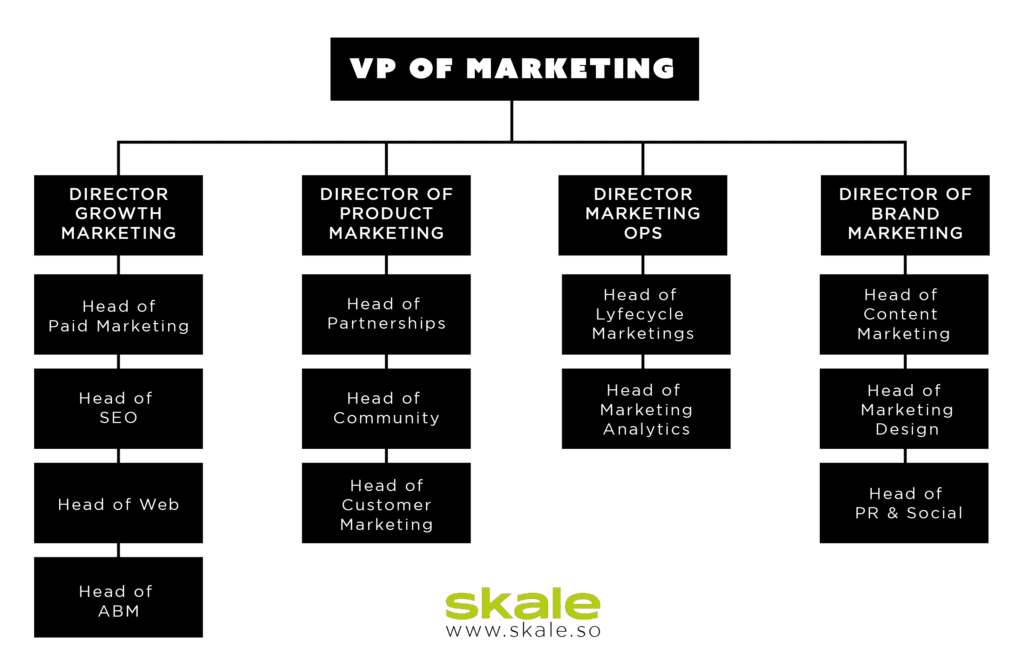
Growth, growth, growth. We’re rocking, we’re rolling, we’ve secured funding, we’ve got fruitful budgets in each department. This is every SaaS business’s dream marketing team set up. We’ve removed the smaller roles here; otherwise, this infographic wouldn’t fit on the page. However, you should have a clear idea of department breakdown and potential roles to go under each ‘Head of.’
Two things worth noting here? Head of ABM and Head of PR & Social Media. Usually, this is for when you want to go >$40m and need to get very specific to start targeting Enterprise businesses. At this point you can afford to invest in these roles as the contract values you’re bringing to the company are worth the upfront costs. Plus, you’re bringing a new level of awareness to your brand and product that’s data-driven and strategic.

Learn how you can use a P&L approach to spend to leverage growth from your SaaS marketing efforts
Read the guideFamiliar with the Spotify squads framework? If not, you can read all about it here. In short, Spotify set up an ideal culture and structure for their engineering teams. It involved a massive amount of autonomy for their teams, its own language, and even product development methods.
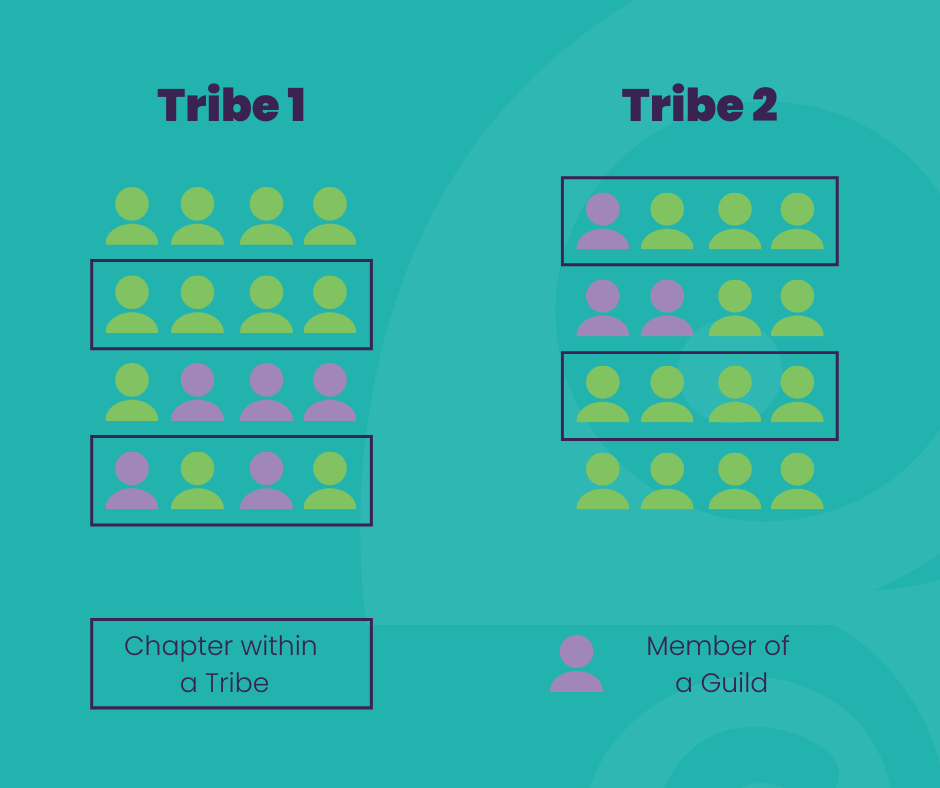
It’s also notorious for failing. However, that’s not to say SaaS marketing teams can’t learn a thing of two from Spotify squads. In particular, chapters and guilds.
Furthermore, it’s common for there to be confusion around marketing talent and the department they should fall under; who is managing who?
For example, does social fall under content or growth? Does sales enablement come with product or content teams? The truth is, there’s no right or wrong answer—it’s whatever suits your business culture best.
However, don’t be afraid to borrow elements of Spotify Squads to connect and guide rolls via mutual knowledge or interests. Investing in guilds and chapters across departments will help cross-team collaboration and ensure positive mentorship from leaders with different yet relevant experience.
Right, that’s the basics of a SaaS marketing team structure covered, ready to dive into what the SaaS experts had to say? We thought you’d never ask.
The ways we’ve suggested above may not work for you, and that’s totally fine. We asked 11 SaaS experts to find out what worked best for them to get some more varied feedback. Our questions were:
Here’s what they had to say.
“I’ve seen success when focusing on two types of teams: a growth team and a marketing team.
The marketing team focuses on branding, positioning, product messaging, and more typical aspects of marketing.
Don’t underestimate the power of branding and storytelling, you need to impact that psychological part of your customers’ awareness and consideration phases.
Your growth team acts as a consultancy team and works with every department.
Your growth team should map out the customer journey based on the pirate funnel. They should work closely with sales and customer success teams to ensure the funnel is implemented across all customer-facing departments. It helps if the growth team holds weekly sessions with department heads.
A front-end developer or growth engineer and some kind of (general) project manager that can ensure everyone stays on track are really useful too.”
— Rabin (拉宾) Nuchtabek, Chief Growth Engineer @ Skedify.

We highlight the tactics top SaaS brands used to boost MRR and lower CAC
Read the list“Focus on content from the beginning. Try to find at least four full-time content people and five or so freelancers. You’ll need two content managers, a link builder, and a Head of Growth.
Put your PPC campaigns in the hands of your head of growth for data-driven success.”
—Daniil Kopilevych, Head of Growth at Profi.
“Generally, I would have a couple of writers, an editor, somebody to take on audio or video, and then probably two or three people who take on content marketing strategies. You need to include content promotion, market research, customer interviews—those kinds of things.
It really depends, some have a team of over 30 people, and then other companies have lean teams of three people. It fully depends on the market, the product, and the brand’s maturity of the company.
—Kevin Indig, Director of SEO @ Shopify.
“The stage of the company, type of product, growth and sales motion, and audience are all factors that impact the SaaS marketing team structure, so there’s no one optimum structure that would work for every SaaS company.
The functions of product marketing, sales enablement, content marketing, acquisition marketing, lifecycle marketing, event marketing, social, and community could all be part of the structure, but some companies may only need some of them to start and grow as needs expand.
It’s important to balance the resource and impact of each function to make sure you’re focusing on the highest leverage functions first before building out a big team.”
—Holly Chen, Marketing Advisor @ Loom, nTopology, Miro, ServiceNow.
“I’m a big believer of cross-functional teams so that teams are autonomous to achieve what they need to achieve. I’m also a big believer in frequent re-structures to accommodate for improving execution on the plans for the foreseeable future.
At Holded, we are product-led, and from 2021 we will actually have a team called exactly Product led Growth. This is the team that scales the main direct-to-customer channels but taking care of the full user journey these people have.
Inside this team, we have channel experts, and then the left-brain and right-brain people: creatives and data analysts. Additionally, we have teams for scaling channels through partnerships, and a brand team to work on our brand awareness and affinity.
The point is always: define what you need to achieve and then structure your team around it. Forget about how other companies structure their teams.”
—Adelina Peltea, VP of Growth at Holded.
“I think it depends on the size of the company you’re at. A thousand-person SaaS company is way different from a 20-person one. It really comes down to your team structure in your early stages. I think having generalists who can do a lot of different things is really important.
Once you start to advance a little bit and grow the team out, it comes down to five buckets:
– Growth
– Content
– Product marketing
– Design
– Ops & analytics
This structure helps out, and it creates very clear lines of what people should be working on, and how we measure the success of those teams.”
—Adam Goyette, VP Marketing at Help Scout.
“There is not a one-size-fits-all approach here. It really depends on your go-to-market motion because the marketing team has to really reflect that.
If you’re more of an online trial-type and it’s mostly self-directed, you may lean to having roles that are more focused on building out really deep technical content that attracts people. Content that’s really SEO friendly, gets people into the funnel, and allows them to be successful as they go and try and deploy your product.
If it’s more of an enterprise sale, you might need to invest more in building up sales, focus on resources and customer case studies and testimonials and videos to help sales teams close that sale.
But in general, for every marketing team, every SaaS marketing team, you have to have someone who is in charge of driving demand to perform for the business. You have to have someone who’s thinking about how you go outside and communicate, how you interact with press and media, and really get those messages out in the market.
One important role that sometimes gets overlooked is to have someone who’s really operations-focused, who understands the tools that you’re using, the data that’s coming in, and can get things done.
They want to work with different teams across the business, and that’s quite important.
Last but not least, of course, I think you always have to have someone focused on the content side. So who’s really understanding the needs and what kind of content is necessary to deliver to your audience how your directly responding to trends in the marketplace and really creating deep, engaging stuff that’s a fit for your audience.
Obviously, it evolves over time.”
—Baxter Denney, Various growth leadership roles @ Citrix, Couchbase, NewRelic, RedPoints.
“It’s something that I’ve done a couple of times now. I truly believe that if you could hire one person within a marketing team to start out with I’d go with content marketing and growth marketing or demand gen. Those two people can scale your awareness. Without the content marketer there’s no point in having a growth marketer.
A great way to start, even with junior members, is someone who has flare with content and is curious about your audience, wants to dive deep in understanding them, and creates a process around the different types of content you need to roll out. This content marketer becomes super useful, even with a low budget When it comes to social qualms, cms, landing pages—it’s a critical hire.
The growth marketer can join a little after the content marketer is a great way to go for amplifying your reach. It’s so important though, that you understand your budget when you hire this role. This role needs to be able to experiment, and if you don’t have budget, it might make sense to work with an SEO freelancer or another content marketer to bulk up comms on a lower budget.
As you continue to build your team, it’s important to continue all the facets of B2B SaaS. An events manager could be a huge lead gen role, and to secure sponsors. Plus, product marketing roles are important too bring on post-growth and content roles.
I find these roles via LinkedIn job boards. But, in general, try to meet people where they are. For example, if it’s a marketing role they’re on LinkedIn. However, if it’s a graphic design role, check out The Dots. Go to the platforms your people are using.”
—Meagan Healey, Director, Marketing & Communications @ Dig Insights.
“Assumption: The company is in the early stages. The first 25-50 customers are acquired and problem use cases solved by the product is established, and some PMF established. The company is seeing smooth movement from Demo to Free Trial to Conversion.
In this case, the first team to be hired is a Demand Generation expert ( Google PPC + FB + LinkedIn) and a Content Specialist.
The Google PPC expert will help with bidding on the right keywords to bring inbound leads.
The Content Specialist will revamp the site content for getting the right message across when people land on the site.
If it is very early stage, then the only model which works is founder-led Cold Email/LinkedIn based outbound sales, Trial + Conversion long cycle sales to get to the early customers.
At Mid-Stage, the team can be split along the following lines:
Content Marketing: Team to develop ideas and write content showcasing the value proposition of the product and customer pain points. This team would also lead the community-building efforts for the product ( like Slack Group, Podcast etc).
Later you can add a field marketing team, account-based marketing, and conducting Webinars closely with customer success.
Demand Generation and Marketing Ops team: PPC, SEO, and Campaign management team across channels. This is the most important team and gets the leads flowing. They should have complete full-funnel visibility, and the Ops team holds all the key product acquisition, integration of data, and analytics.
SDR Team: SDR Team should be reporting to the Growth/Marketing teams in SaaS. They work with Marketing Ops to convert the leads to demand pipeline.”
—Srikrishna Swaminathan, Co-Founder at Factors.AI
“During the early days of your SaaS, you absolutely need a generalist. Someone who can be flexible, try out different things, and figure out what works and what doesn’t. As you identify what’s working, you should then hire people to scale that up. As for finding people to fit these roles, there are some excellent communities online for marketers but don’t forget to ask your own network.”
—Sid Bharath, Co-Founder of Broca.
“I would say that product marketing is a critical function, and I think especially in the early days, product marketers can be a Swiss Army knife working on launches, messaging, landing pages, onboarding content, customer research. They’re a very important function.
I would say another pillar function within marketing tends to always be growth or demand generation, again, depending on the strategy of your company and the organizational setup, sometimes there are separate growth teams that cover product and marketing growth.
Whereas, sometimes there is growth and demand generation. It really just depends on your organization.
I also think in general, in marketing, there is a function that focuses on user acquisition and this can include different things depending on the channels that you decide to focus on: performance marketing, so paid SEO strategic partnerships, conversion rate optimization lifecycle marketing, to name a few.
I think another pillar that’s common across most companies is a team that focuses on content that could translate into Brand.
A lot of companies, especially if you’re looking at more than a self-serve funnel, produce a lot of content. It’s a critical function.
On a side note, I would say that there are two functions that I think are often implemented too late or sometimes forgotten about, and those are marketing operations and product marketing.
I think they’re often brought in too late, but they can have such a huge impact on the team and success if they’re brought in early. These two functions, in my opinion, really build the right foundations for growth and for a scalable marketing team.
My last thing here on the hiring front is I would recommend hiring a generalist Swiss Army knife early on that’s eager to learn and have an impact. Once you’ve identified the areas you want to scale, you can bring in specialists that can then really focus on optimization.”
— Bożena Pieniazek, Director of Marketing @ Maze.
Go to where the person you want is. Different roles tend to sit on different channels. Designers and other content-orientated roles tend to use job boards and social media. Whereas growth positions or senior roles can be found on LinkedIn. Like with marketing, figure out where your audience is and go there.
You’ll need to find a good all-rounder. They’re out there! It’s best if you get someone on board that’s worked in a startup or startup environment before. Look for Multi-faceted or T-shaped people—those with transferable skills and perhaps 2-3 technical skills they specialize in. It’s important this person is data-driven, goal-orientated, and are hungry for growth within the company.
There is no one-size-fits-all answer for this. Things to consider are:
The stage of your SaaS business (e.g. pre-seed, scale-up, or growth)
Your acquisition model (e.g., self-served, sales-led, or blended)
Average Contract Value
SaaS marketing spend requires a careful balance. Don’t spend enough, and you’ll hinder growth; spend too much, and you’ll impact business sustainability.
You need to establish what your short-mid-term growth targets are and how you measure success. Are you looking for fast signups? higher LTV users? A predictable pipeline for the sales team? What are your current and what are your expected growth rates?
Then it’s time for the numbers. Assuming you have your CAC and LTV nailed down, you want to get your LTV:CAC ratio to 3:1 within a maximum payback period of 12 months to achieve sustainable growth for your SaaS.
Monitor and aim to be within this ratio. If your LTV:CAC ratio declines, think of pivoting to the most efficient channels and get the ratio back under control.
Check our article on measuring SEO ROI for SaaS if you don’t know your LTV yet. Here you’ll learn how to make these calculations more on measuring ROI. The model applies to all marketing investments.
Research shows that a SaaS company with less than 50 employees should have a marketing team at around 5% of its total human resources. In contrast, companies with over 50 employees tend to have a marketing team of 8% or more. Although, at Skale, we would recommend a little more, as you’ll see in our org structure set up earlier in this article.
This is a huge culture and maturity question. What type of marketing department do you want to build, and what extent of leadership and guidance do your people need to be successful.
Smaller marketing teams tend to be very flat, with one member of leadership within marketing.
However, larger, more corporate teams tend to have multiple layers of management. Really it comes down to other marketing team members and company culture.
Learn more about
SaaS Marketing

The best 8 SaaS marketing events to attend in 2024
In this comprehensive guide, we'll showcase some of the best SaaS marketing events in 2024 that you shouldn't miss.

7 Best SaaS Copywriting Agencies & Services in 2024
11+ SaaS copywriting agencies that will educate your audience, boost revenue, and nurture leads.

9 SaaS Content Marketing Agencies in 2024: Reviews & Pricing
Create content that generates serious revenue when you work with a SaaS marketing agency from this list.